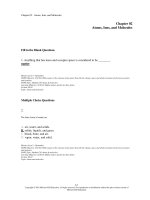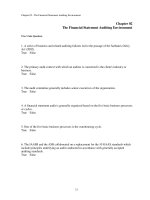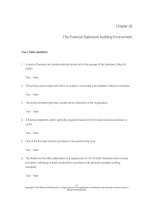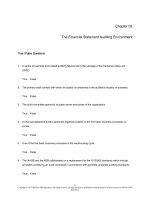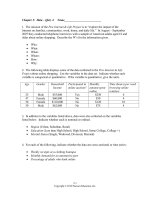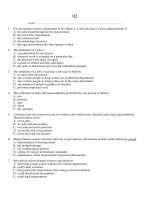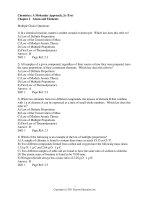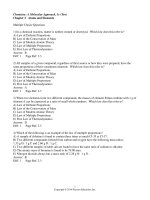Microbiology fundamentals a clinical approach 2nd edition cowan test bank
Bạn đang xem bản rút gọn của tài liệu. Xem và tải ngay bản đầy đủ của tài liệu tại đây (343.17 KB, 40 trang )
Chapter 02 - Tools of the Laboratory: Methods for the Culturing and Microscopic Analysis
Chapter 02
Tools of the Laboratory: Methods for the Culturing and Microscopic
Analysis
Multiple Choice Questions
1. The Five I's of studying microorganisms include all of the following except
A. inoculation.
B. incubation.
C. infection.
D. isolation.
E. identification.
ASM Objective: 08.02 Use pure culture and selective techniques to enrich for and isolate microorganisms.
ASM Objective: 08.03 Use appropriate methods to identify microorganisms (media-based, molecular and serological).
ASM Topic: Module 08 Microbiology Skills
Bloom's Level: 01. Remember
Learning Outcome: 02.01 Explain what the Five I’s are and what each step entails.
Section: 02.01
Topic: Culturing Microorganisms
Topic: Identifying Microorganisms
2. The term that refers to the purposeful addition of microorganisms into a laboratory nutrient
medium is
A. isolation.
B. inoculation.
C. immunization.
D. infection.
E. contamination.
ASM Objective: 08.02 Use pure culture and selective techniques to enrich for and isolate microorganisms.
ASM Topic: Module 08 Microbiology Skills
Bloom's Level: 01. Remember
Learning Outcome: 02.01 Explain what the Five I’s are and what each step entails.
Section: 02.01
Topic: Culturing Microorganisms
2-1
Copyright © 2016 McGraw-Hill Education. All rights reserved. No reproduction or distribution without the prior written consent of
McGraw-Hill Education.
Chapter 02 - Tools of the Laboratory: Methods for the Culturing and Microscopic Analysis
3. A pure culture contains
A. only one species of microorganism.
B. only bacteria.
C. a variety of microbes from one source.
D. a variety of species from the same genus.
E. None of the choices is correct.
ASM Objective: 08.02 Use pure culture and selective techniques to enrich for and isolate microorganisms.
ASM Topic: Module 08 Microbiology Skills
Bloom's Level: 01. Remember
Learning Outcome: 02.01 Explain what the Five I’s are and what each step entails.
Section: 02.01
Topic: Culturing Microorganisms
4. The correct microbiological term for the tiny sample of specimen that is put into a nutrient
medium in order to produce a culture is the
A. colony.
B. inoculum.
C. streak.
D. loop.
E. None of the choices is correct.
ASM Objective: 08.02 Use pure culture and selective techniques to enrich for and isolate microorganisms.
ASM Topic: Module 08 Microbiology Skills
Bloom's Level: 01. Remember
Learning Outcome: 02.01 Explain what the Five I’s are and what each step entails.
Section: 02.01
Topic: Culturing Microorganisms
5. Which of the following is essential for development of discrete, isolated colonies?
A. broth medium
B. differential medium
C. selective medium
D. solid medium
E. assay medium
ASM Objective: 08.02 Use pure culture and selective techniques to enrich for and isolate microorganisms.
ASM Topic: Module 08 Microbiology Skills
Bloom's Level: 01. Remember
Learning Outcome: 02.01 Explain what the Five I’s are and what each step entails.
Learning Outcome: 02.02 Discuss three physical states of media and when each is used.
Section: 02.01
Topic: Culturing Microorganisms
2-2
Copyright © 2016 McGraw-Hill Education. All rights reserved. No reproduction or distribution without the prior written consent of
McGraw-Hill Education.
Chapter 02 - Tools of the Laboratory: Methods for the Culturing and Microscopic Analysis
6. Which method often results in colonies developing down throughout the agar along with
some colonies on the surface?
A. streak plate
B. spread plate
C. pour plate
D. All of the choices are correct.
E. None of the choices is correct.
ASM Objective: 08.02 Use pure culture and selective techniques to enrich for and isolate microorganisms.
ASM Topic: Module 08 Microbiology Skills
Bloom's Level: 01. Remember
Learning Outcome: 02.01 Explain what the Five I’s are and what each step entails.
Section: 02.01
Topic: Culturing Microorganisms
7. What type of isolation technique is most effective for the majority of applications?
A. pour plate
B. streak plate
C. spread plate
D. loop dilution
E. culture plate
ASM Objective: 08.02 Use pure culture and selective techniques to enrich for and isolate microorganisms.
ASM Topic: Module 08 Microbiology Skills
Bloom's Level: 01. Remember
Learning Outcome: 02.01 Explain what the Five I’s are and what each step entails.
Section: 02.01
Topic: Culturing Microorganisms
2-3
Copyright © 2016 McGraw-Hill Education. All rights reserved. No reproduction or distribution without the prior written consent of
McGraw-Hill Education.
Chapter 02 - Tools of the Laboratory: Methods for the Culturing and Microscopic Analysis
8.
Which of the following will result when 1% to 5% agar is added to nutrient broth, boiled, and cooled?
A. a pure culture
B. a mixed culture
C. a solid medium
D. a liquid medium
E. a contaminated medium
ASM Objective: 08.03 Use appropriate methods to identify microorganisms (media-based, molecular and serological).
ASM Topic: Module 08 Microbiology Skills
Bloom's Level: 01. Remember
Learning Outcome: 02.02 Discuss three physical states of media and when each is used.
Section: 02.01
Topic: Culturing Microorganisms
9. Agar is an important component of media because
A. bacteria require agar to grow.
B. agar inhibits mold growth.
C. agar provides a solid surface for bacterial growth.
D. agar prevents contamination.
E. All of the choices are correct.
ASM Objective: 08.03 Use appropriate methods to identify microorganisms (media-based, molecular and serological).
ASM Topic: Module 08 Microbiology Skills
Bloom's Level: 01. Remember
Learning Outcome: 02.02 Discuss three physical states of media and when each is used.
Section: 02.01
Topic: Culturing Microorganisms
2-4
Copyright © 2016 McGraw-Hill Education. All rights reserved. No reproduction or distribution without the prior written consent of
McGraw-Hill Education.
Chapter 02 - Tools of the Laboratory: Methods for the Culturing and Microscopic Analysis
10. The three physical forms of laboratory media are
A. solid, liquid, and gas.
B. solid, semisolid, and liquid.
C. streak plate, pour plate, and broth.
D. aerobic, anaerobic, and micro aerobic.
E. None of the choices is correct.
ASM Objective: 08.03 Use appropriate methods to identify microorganisms (media-based, molecular and serological).
ASM Topic: Module 08 Microbiology Skills
Bloom's Level: 01. Remember
Learning Outcome: 02.02 Discuss three physical states of media and when each is used.
Section: 02.01
Topic: Culturing Microorganisms
11. Which of the following is not an inoculating tool?
A. petri dish
B. loop
C. needle
D. pipette
E. swab
ASM Objective: 08.02 Use pure culture and selective techniques to enrich for and isolate microorganisms.
ASM Objective: 08.03 Use appropriate methods to identify microorganisms (media-based, molecular and serological).
ASM Topic: Module 08 Microbiology Skills
Bloom's Level: 01. Remember
Learning Outcome: 02.01 Explain what the Five I’s are and what each step entails.
Section: 02.01
Topic: Culturing Microorganisms
2-5
Copyright © 2016 McGraw-Hill Education. All rights reserved. No reproduction or distribution without the prior written consent of
McGraw-Hill Education.
Chapter 02 - Tools of the Laboratory: Methods for the Culturing and Microscopic Analysis
12.
Agar is a complex polysaccharide that comes from a(n)
A. green plant.
B. fungus.
C. mold.
D. algae.
E. euglena.
ASM Objective: 08.03 Use appropriate methods to identify microorganisms (media-based, molecular and serological).
ASM Topic: Module 08 Microbiology Skills
Bloom's Level: 01. Remember
Learning Outcome: 02.02 Discuss three physical states of media and when each is used.
Section: 02.01
Topic: Culturing Microorganisms
13. Which of the following is not a benefit of agar as a solid medium?
A.
has flexibility
B. holds moisture
C. can be inoculated and poured at a temperature that is not harmful
D.
is solid at room temperature
E. is digested by most microbes
ASM Objective: 08.02 Use pure culture and selective techniques to enrich for and isolate microorganisms.
ASM Objective: 08.03 Use appropriate methods to identify microorganisms (media-based, molecular and serological).
ASM Topic: Module 08 Microbiology Skills
Bloom's Level: 01. Remember
Learning Outcome: 02.02 Discuss three physical states of media and when each is used.
Section: 02.01
Topic: Culturing Microorganisms
2-6
Copyright © 2016 McGraw-Hill Education. All rights reserved. No reproduction or distribution without the prior written consent of
McGraw-Hill Education.
Chapter 02 - Tools of the Laboratory: Methods for the Culturing and Microscopic Analysis
14.
A nutrient medium that has all of its chemical components identified, and their precise concentrations known and
reproducible, would be termed
A. complex.
B. reducing.
C. enriched.
D.
chemically defined.
E. None of the choices is correct.
ASM Objective: 08.02 Use pure culture and selective techniques to enrich for and isolate microorganisms.
ASM Topic: Module 08 Microbiology Skills
Bloom's Level: 01. Remember
Learning Outcome: 02.04 Provide brief definitions for defined media and complex media.
Section: 02.01
Topic: Culturing Microorganisms
15. A nutrient medium that contains at least one ingredient that is NOT chemically definable
would be termed
A. complex.
B. reducing.
C. enriched.
D. synthetic.
E. None of the choices is correct.
ASM Objective: 08.02 Use pure culture and selective techniques to enrich for and isolate microorganisms.
ASM Topic: Module 08 Microbiology Skills
Bloom's Level: 01. Remember
Learning Outcome: 02.04 Provide brief definitions for defined media and complex media.
Section: 02.01
Topic: Culturing Microorganisms
2-7
Copyright © 2016 McGraw-Hill Education. All rights reserved. No reproduction or distribution without the prior written consent of
McGraw-Hill Education.
Chapter 02 - Tools of the Laboratory: Methods for the Culturing and Microscopic Analysis
16. All of the following are examples of different types of microbiological media except
A. broth.
B. enriched.
C. agar.
D. petri dish.
E. selective.
ASM Objective: 08.03 Use appropriate methods to identify microorganisms (media-based, molecular and serological).
ASM Topic: Module 08 Microbiology Skills
Bloom's Level: 01. Remember
Learning Outcome: 02.02 Discuss three physical states of media and when each is used.
Learning Outcome: 02.03 Compare and contrast selective and differential media, and give an example of each.
Section: 02.01
Topic: Culturing Microorganisms
17. Which type of media would be the best choice when shipping a sample of bacteria to a
laboratory to be tested from a satellite office site?
A. transport
B. EMB
C. blood
D. thioglycollate
E. general purpose
ASM Objective: 08.03 Use appropriate methods to identify microorganisms (media-based, molecular and serological).
ASM Objective: 08.05 Use appropriate microbiological and molecular lab equipment and methods.
ASM Topic: Module 08 Microbiology Skills
Bloom's Level: 02. Understand
Learning Outcome: 02.03 Compare and contrast selective and differential media, and give an example of each.
Section: 02.01
Topic: Culturing Microorganisms
2-8
Copyright © 2016 McGraw-Hill Education. All rights reserved. No reproduction or distribution without the prior written consent of
McGraw-Hill Education.
Chapter 02 - Tools of the Laboratory: Methods for the Culturing and Microscopic Analysis
18. A microbiologist inoculates Staphylococcus epidermidis and Escherichia coli into a
culture medium. Following incubation, only the E. coli grows in the culture. What is the most
likely explanation?
A. The microbiologist used too much inoculum.
B. The culture is contaminated.
C. The incubation temperature was incorrect.
D. The culture medium must be selective.
E. The culture medium must be differential.
ASM Objective: 07.01b Ability to apply the process of science: Analyze and interpret results from a variety of microbiological methods and
apply these methods to analogous situations.
ASM Objective: 08.02 Use pure culture and selective techniques to enrich for and isolate microorganisms.
ASM Topic: Module 07 Scientific Thinking
ASM Topic: Module 08 Microbiology Skills
Bloom's Level: 03. Apply
Learning Outcome: 02.01 Explain what the Five I’s are and what each step entails.
Section: 02.01
Topic: Culturing Microorganisms
19. A common medium used for growing fastidious bacteria is
A. blood agar.
B. trypticase soy agar.
C. mannitol salt agar.
D. MacConkey medium.
E. a reducing medium.
ASM Objective: 03.03 The survival and growth of any microorganism in a given environment depends on its metabolic characteristics.
ASM Objective: 08.02 Use pure culture and selective techniques to enrich for and isolate microorganisms.
ASM Topic: Module 03 Metabolic Pathways
ASM Topic: Module 08 Microbiology Skills
Bloom's Level: 01. Remember
Learning Outcome: 02.04 Provide brief definitions for defined media and complex media.
Section: 02.01
Topic: Culturing Microorganisms
Topic: Microbial Growth and Nutrition
2-9
Copyright © 2016 McGraw-Hill Education. All rights reserved. No reproduction or distribution without the prior written consent of
McGraw-Hill Education.
Chapter 02 - Tools of the Laboratory: Methods for the Culturing and Microscopic Analysis
20. A reducing medium contains
A. sugars that can be fermented.
B. extra oxygen.
C. hemoglobin, vitamins, or other growth factors.
D. substances that remove oxygen.
E. inhibiting agents.
ASM Objective: 08.03 Use appropriate methods to identify microorganisms (media-based, molecular and serological).
ASM Topic: Module 08 Microbiology Skills
Bloom's Level: 01. Remember
Learning Outcome: 02.03 Compare and contrast selective and differential media, and give an example of each.
Section: 02.01
Topic: Culturing Microorganisms
21. Which type of medium is able to distinguish different species or types of microorganisms
based on an observable change in the colonies or in the medium?
A. differential
B. selective
C. enumeration
D. enriched
E. reducing
ASM Objective: 08.03 Use appropriate methods to identify microorganisms (media-based, molecular and serological).
ASM Topic: Module 08 Microbiology Skills
Bloom's Level: 01. Remember
Learning Outcome: 02.03 Compare and contrast selective and differential media, and give an example of each.
Section: 02.01
Topic: Culturing Microorganisms
Topic: Identifying Microorganisms
22. Differential media results in which of the following growth characteristics?
A. different color colonies
B. different media color post incubation
C. precipitates
D. gas bubbles
E. All of the choices are correct.
ASM Objective: 08.03 Use appropriate methods to identify microorganisms (media-based, molecular and serological).
ASM Topic: Module 08 Microbiology Skills
Bloom's Level: 02. Understand
Learning Outcome: 02.03 Compare and contrast selective and differential media, and give an example of each.
Section: 02.01
Topic: Culturing Microorganisms
2-10
Copyright © 2016 McGraw-Hill Education. All rights reserved. No reproduction or distribution without the prior written consent of
McGraw-Hill Education.
Chapter 02 - Tools of the Laboratory: Methods for the Culturing and Microscopic Analysis
23. A reducing media is used to culture
A. fastidious organisms.
B. aerobic organisms.
C. anaerobic organisms.
D. any pathogenic organisms.
E. None of the choices is correct.
ASM Objective: 03.03 The survival and growth of any microorganism in a given environment depends on its metabolic characteristics.
ASM Objective: 08.03 Use appropriate methods to identify microorganisms (media-based, molecular and serological).
ASM Topic: Module 03 Metabolic Pathways
ASM Topic: Module 08 Microbiology Skills
Bloom's Level: 02. Understand
Learning Outcome: 02.03 Compare and contrast selective and differential media, and give an example of each.
Section: 02.01
Topic: Culturing Microorganisms
Topic: Microbial Growth and Nutrition
24. For which bacterial genus does mannitol salt agar differentiate between species?
A. Salmonella
B. Streptococcus
C. Neisseria
D. Staphylococcus
E. Escherichia
ASM Objective: 08.03 Use appropriate methods to identify microorganisms (media-based, molecular and serological).
ASM Topic: Module 08 Microbiology Skills
Bloom's Level: 02. Understand
Learning Outcome: 02.03 Compare and contrast selective and differential media, and give an example of each.
Section: 02.01
Topic: Culturing Microorganisms
Topic: Identifying Microorganisms
2-11
Copyright © 2016 McGraw-Hill Education. All rights reserved. No reproduction or distribution without the prior written consent of
McGraw-Hill Education.
Chapter 02 - Tools of the Laboratory: Methods for the Culturing and Microscopic Analysis
25. A microbiologist must culture a patient's feces for intestinal pathogens. Which of the
following would likely be present in selective media for analyzing this fecal specimen?
A. NaCl
B. sheep red blood cells
C. bile salts
D. thioglycollic acid
E. peptone
ASM Objective: 08.02 Use pure culture and selective techniques to enrich for and isolate microorganisms.
ASM Objective: 08.03 Use appropriate methods to identify microorganisms (media-based, molecular and serological).
ASM Topic: Module 08 Microbiology Skills
Bloom's Level: 02. Understand
Learning Outcome: 02.03 Compare and contrast selective and differential media, and give an example of each.
Section: 02.01
Topic: Culturing Microorganisms
Topic: Identifying Microorganisms
26. Bacteria that require special growth factors and complex nutrients are termed
A. aerobic.
B. anaerobic.
C. fastidious.
D. microaerophilic.
E. autotrophic.
ASM Objective: 03.03 The survival and growth of any microorganism in a given environment depends on its metabolic characteristics.
ASM Topic: Module 03 Metabolic Pathways
Bloom's Level: 01. Remember
Learning Outcome: 02.03 Compare and contrast selective and differential media, and give an example of each.
Section: 02.01
Topic: Culturing Microorganisms
Topic: Microbial Growth and Nutrition
2-12
Copyright © 2016 McGraw-Hill Education. All rights reserved. No reproduction or distribution without the prior written consent of
McGraw-Hill Education.
Chapter 02 - Tools of the Laboratory: Methods for the Culturing and Microscopic Analysis
27. A microbiologist inoculates Staphylococcus aureus into a culture medium. Following
incubation, both Staphylococcus aureus and Staphylococcus epidermidis are determined to be
growing in this culture. What is the most likely explanation?
A. The microbiologist used too much inoculum.
B. The culture is contaminated.
C. The incubation temperature was incorrect.
D. The culture medium must be selective.
E. The culture medium must be differential.
ASM Objective: 07.01b Ability to apply the process of science: Analyze and interpret results from a variety of microbiological methods and
apply these methods to analogous situations.
ASM Objective: 08.02 Use pure culture and selective techniques to enrich for and isolate microorganisms.
ASM Objective: 08.03 Use appropriate methods to identify microorganisms (media-based, molecular and serological).
ASM Topic: Module 07 Scientific Thinking
ASM Topic: Module 08 Microbiology Skills
Bloom's Level: 03. Apply
Learning Outcome: 02.01 Explain what the Five I’s are and what each step entails.
Section: 02.01
Topic: Culturing Microorganisms
28. Newly inoculated cultures must be _____ at a specific temperature to encourage growth.
A. streaked
B. poured
C. incubated
D. contaminated
E. All of the choices are correct.
ASM Objective: 03.03 The survival and growth of any microorganism in a given environment depends on its metabolic characteristics.
ASM Objective: 03.04 The growth of microorganisms can be controlled by physical, chemical, mechanical, or biological means.
ASM Objective: 08.05 Use appropriate microbiological and molecular lab equipment and methods.
ASM Topic: Module 03 Metabolic Pathways
ASM Topic: Module 08 Microbiology Skills
Bloom's Level: 01. Remember
Section: 02.01
Topic: Culturing Microorganisms
Topic: Microbial Growth and Nutrition
2-13
Copyright © 2016 McGraw-Hill Education. All rights reserved. No reproduction or distribution without the prior written consent of
McGraw-Hill Education.
Chapter 02 - Tools of the Laboratory: Methods for the Culturing and Microscopic Analysis
29.
A rod-shaped bacterium is measured as 0.3 micrometers (m) in length using an ocular micrometer. Your instructor wants
you to report the length in millimeters (mm) to test your understanding of metric conversions. What is the length of the
organism in millimeters?
A.
300 mm
B.
0.0003 mm
C.
0.03 mm
D.
3 mm
ASM Objective: 07.02 Ability to use quantitative reasoning: Use mathematical reasoning and graphing skills to solve problems in
microbiology.
ASM Topic: Module 07 Scientific Thinking
Bloom's Level: 02. Understand
Learning Outcome: 02.05 Convert among the different units of the metric system.
Section: 02.02
Topic: Microscopy
2-14
Copyright © 2016 McGraw-Hill Education. All rights reserved. No reproduction or distribution without the prior written consent of
McGraw-Hill Education.
Chapter 02 - Tools of the Laboratory: Methods for the Culturing and Microscopic Analysis
30.
An enveloped virus measures 0.02 micrometers (m) in diameter. What is the diameter of this virus in nanometers (nm)?
A.
2 nm
B.
20 nm
C.
0.00002 nm
D.
0.2 nm
ASM Objective: 07.02 Ability to use quantitative reasoning: Use mathematical reasoning and graphing skills to solve problems in
microbiology.
ASM Topic: Module 07 Scientific Thinking
Bloom's Level: 02. Understand
Learning Outcome: 02.05 Convert among the different units of the metric system.
Section: 02.02
Topic: Microscopy
31. The _____ of the microscope holds and allows selection of the objective lenses.
A. stage
B. condenser
C. objective
D. ocular
E. nosepiece
ASM Objective: 08.01 Properly prepare and view specimens for examination using microscopy (bright field and, if possible, phase contrast).
ASM Objective: 08.05 Use appropriate microbiological and molecular lab equipment and methods.
ASM Topic: Module 08 Microbiology Skills
Bloom's Level: 01. Remember
Learning Outcome: 02.07 Differentiate between the principles of light microscopy and the principles of electron microscopy.
Section: 02.02
Topic: Microscopy
2-15
Copyright © 2016 McGraw-Hill Education. All rights reserved. No reproduction or distribution without the prior written consent of
McGraw-Hill Education.
Chapter 02 - Tools of the Laboratory: Methods for the Culturing and Microscopic Analysis
32.
Which of the following magnifies the specimen to produce its real image?
A. condenser
B. objective lens
C. ocular lens
D. body
E. nosepiece
ASM Objective: 08.01 Properly prepare and view specimens for examination using microscopy (bright field and, if possible, phase contrast).
ASM Objective: 08.05 Use appropriate microbiological and molecular lab equipment and methods.
ASM Topic: Module 08 Microbiology Skills
Bloom's Level: 01. Remember
Learning Outcome: 02.07 Differentiate between the principles of light microscopy and the principles of electron microscopy.
Section: 02.02
Topic: Microscopy
33.
Which of the following magnifies the specimen to produce its virtual image?
A. objective lens
B. ocular lens
C. condenser
D. body
E. iris diaphragm
ASM Objective: 08.01 Properly prepare and view specimens for examination using microscopy (bright field and, if possible, phase contrast).
ASM Objective: 08.05 Use appropriate microbiological and molecular lab equipment and methods.
ASM Topic: Module 08 Microbiology Skills
Bloom's Level: 01. Remember
Learning Outcome: 02.07 Differentiate between the principles of light microscopy and the principles of electron microscopy.
Section: 02.02
Topic: Microscopy
2-16
Copyright © 2016 McGraw-Hill Education. All rights reserved. No reproduction or distribution without the prior written consent of
McGraw-Hill Education.
Chapter 02 - Tools of the Laboratory: Methods for the Culturing and Microscopic Analysis
34. Which of the following controls the amount of light entering the specimen?
A. objective lens
B. ocular lens
C. condenser
D. body
E. iris diaphragm
ASM Objective: 08.01 Properly prepare and view specimens for examination using microscopy (bright field and, if possible, phase contrast).
ASM Objective: 08.05 Use appropriate microbiological and molecular lab equipment and methods.
ASM Topic: Module 08 Microbiology Skills
Bloom's Level: 01. Remember
Learning Outcome: 02.07 Differentiate between the principles of light microscopy and the principles of electron microscopy.
Section: 02.02
Topic: Microscopy
35. If a microbiologist is studying a specimen at a total magnification of 950x, what is the
magnifying power of the objective lens if the ocular lens is 10x?
A. 100x
B. 950x
C. 85x
D. 850x
E. 95x
ASM Objective: 08.01 Properly prepare and view specimens for examination using microscopy (bright field and, if possible, phase contrast).
ASM Objective: 08.05 Use appropriate microbiological and molecular lab equipment and methods.
ASM Topic: Module 08 Microbiology Skills
Bloom's Level: 02. Understand
Learning Outcome: 02.06 List and describe the three elements of good microscopy.
Learning Outcome: 02.07 Differentiate between the principles of light microscopy and the principles of electron microscopy.
Section: 02.02
Topic: Microscopy
2-17
Copyright © 2016 McGraw-Hill Education. All rights reserved. No reproduction or distribution without the prior written consent of
McGraw-Hill Education.
Chapter 02 - Tools of the Laboratory: Methods for the Culturing and Microscopic Analysis
36. Magnification is achieved in a compound microscope through the initial magnification of
the specimen by the _____ lens. This image is then projected to the _____ lens that will
further magnify the specimen to form a virtual image received by the eye.
A. ocular, objective
B. scanning, objective
C. objective, ocular
D. ocular, oil
E. None of the choices is correct.
ASM Objective: 08.01 Properly prepare and view specimens for examination using microscopy (bright field and, if possible, phase contrast).
ASM Objective: 08.05 Use appropriate microbiological and molecular lab equipment and methods.
ASM Topic: Module 08 Microbiology Skills
Bloom's Level: 01. Remember
Learning Outcome: 02.07 Differentiate between the principles of light microscopy and the principles of electron microscopy.
Section: 02.02
Topic: Microscopy
37. Which of the following characteristics refers to the microscope's ability to show two
separate entities as separate and distinct?
A. resolving power
B. magnification
C. refraction
D. All of the choices are correct.
E. None of the choices is correct.
ASM Objective: 08.01 Properly prepare and view specimens for examination using microscopy (bright field and, if possible, phase contrast).
ASM Objective: 08.05 Use appropriate microbiological and molecular lab equipment and methods.
ASM Topic: Module 08 Microbiology Skills
Bloom's Level: 01. Remember
Learning Outcome: 02.06 List and describe the three elements of good microscopy.
Section: 02.02
Topic: Microscopy
2-18
Copyright © 2016 McGraw-Hill Education. All rights reserved. No reproduction or distribution without the prior written consent of
McGraw-Hill Education.
Chapter 02 - Tools of the Laboratory: Methods for the Culturing and Microscopic Analysis
38.
All of the following are diameters of cells that would be resolved in a microscope with a 0.2 µm limit of resolution except
A. 0.2 µm.
B. 0.2 mm.
C. 0.1 µm.
D. 0.3 µm.
E. 2.0 µm.
ASM Objective: 08.01 Properly prepare and view specimens for examination using microscopy (bright field and, if possible, phase contrast).
ASM Objective: 08.05 Use appropriate microbiological and molecular lab equipment and methods.
ASM Topic: Module 08 Microbiology Skills
Bloom's Level: 02. Understand
Learning Outcome: 02.06 List and describe the three elements of good microscopy.
Section: 02.02
Topic: Microscopy
39. The type of microscope in which you would see brightly illuminated specimens against a
black background is
A.
bright field.
B.
dark field.
C.
phase contrast.
D. fluorescence.
E. electron.
ASM Objective: 08.01 Properly prepare and view specimens for examination using microscopy (bright field and, if possible, phase contrast).
ASM Objective: 08.05 Use appropriate microbiological and molecular lab equipment and methods.
ASM Topic: Module 08 Microbiology Skills
Bloom's Level: 01. Remember
Learning Outcome: 02.07 Differentiate between the principles of light microscopy and the principles of electron microscopy.
Section: 02.02
Topic: Microscopy
2-19
Copyright © 2016 McGraw-Hill Education. All rights reserved. No reproduction or distribution without the prior written consent of
McGraw-Hill Education.
Chapter 02 - Tools of the Laboratory: Methods for the Culturing and Microscopic Analysis
40.
Which type of microscope shows cells against a bright background but also differentiates intracellular structures of unstained
cells based on their varying densities?
A.
bright field
B.
dark field
C.
phase contrast
D. differential interference
E. electron
ASM Objective: 08.01 Properly prepare and view specimens for examination using microscopy (bright field and, if possible, phase contrast).
ASM Objective: 08.05 Use appropriate microbiological and molecular lab equipment and methods.
ASM Topic: Module 08 Microbiology Skills
Bloom's Level: 01. Remember
Learning Outcome: 02.07 Differentiate between the principles of light microscopy and the principles of electron microscopy.
Section: 02.02
Topic: Microscopy
2-20
Copyright © 2016 McGraw-Hill Education. All rights reserved. No reproduction or distribution without the prior written consent of
McGraw-Hill Education.
Chapter 02 - Tools of the Laboratory: Methods for the Culturing and Microscopic Analysis
41. Which type of microscope is the most widely used and shows cells against a bright
background?
A.
bright field
B.
dark field
C.
phase contrast
D. fluorescence
E. electron
ASM Objective: 08.01 Properly prepare and view specimens for examination using microscopy (bright field and, if possible, phase contrast).
ASM Objective: 08.05 Use appropriate microbiological and molecular lab equipment and methods.
ASM Topic: Module 08 Microbiology Skills
Bloom's Level: 01. Remember
Learning Outcome: 02.07 Differentiate between the principles of light microscopy and the principles of electron microscopy.
Section: 02.02
Topic: Microscopy
2-21
Copyright © 2016 McGraw-Hill Education. All rights reserved. No reproduction or distribution without the prior written consent of
McGraw-Hill Education.
Chapter 02 - Tools of the Laboratory: Methods for the Culturing and Microscopic Analysis
42.
All of the following pertain to the fluorescence microscope except it
A. uses electrons to produce a specimen image.
B.
is a type of compound microscope.
C.
requires the use of dyes like acridine and fluorescein.
D. is commonly used to diagnose certain infections.
E. requires an ultraviolet radiation source.
ASM Objective: 08.01 Properly prepare and view specimens for examination using microscopy (bright field and, if possible, phase contrast).
ASM Objective: 08.05 Use appropriate microbiological and molecular lab equipment and methods.
ASM Topic: Module 08 Microbiology Skills
Bloom's Level: 01. Remember
Learning Outcome: 02.07 Differentiate between the principles of light microscopy and the principles of electron microscopy.
Section: 02.02
Topic: Microscopy
2-22
Copyright © 2016 McGraw-Hill Education. All rights reserved. No reproduction or distribution without the prior written consent of
McGraw-Hill Education.
Chapter 02 - Tools of the Laboratory: Methods for the Culturing and Microscopic Analysis
43.
A confocal scanning microscope
A.
uses visible light to form a specimen image.
B. shows three-dimensional cell images from the cell surface to the middle of the cell.
C. produces specimen images on electron micrographs.
D.
uses dyes that emit visible light when bombarded by electrons.
E. requires specimens to be stained.
ASM Objective: 08.01 Properly prepare and view specimens for examination using microscopy (bright field and, if possible, phase contrast).
ASM Objective: 08.05 Use appropriate microbiological and molecular lab equipment and methods.
ASM Topic: Module 08 Microbiology Skills
Bloom's Level: 01. Remember
Learning Outcome: 02.07 Differentiate between the principles of light microscopy and the principles of electron microscopy.
Section: 02.02
Topic: Microscopy
2-23
Copyright © 2016 McGraw-Hill Education. All rights reserved. No reproduction or distribution without the prior written consent of
McGraw-Hill Education.
Chapter 02 - Tools of the Laboratory: Methods for the Culturing and Microscopic Analysis
44. Which type of microscope does not use light in forming the specimen image?
A.
bright field
B.
dark field
C.
phase contrast
D. fluorescence
E. electron
ASM Objective: 08.01 Properly prepare and view specimens for examination using microscopy (bright field and, if possible, phase contrast).
ASM Objective: 08.05 Use appropriate microbiological and molecular lab equipment and methods.
ASM Topic: Module 08 Microbiology Skills
Bloom's Level: 01. Remember
Learning Outcome: 02.07 Differentiate between the principles of light microscopy and the principles of electron microscopy.
Section: 02.02
Topic: Microscopy
2-24
Copyright © 2016 McGraw-Hill Education. All rights reserved. No reproduction or distribution without the prior written consent of
McGraw-Hill Education.
Chapter 02 - Tools of the Laboratory: Methods for the Culturing and Microscopic Analysis
45. Which type of microscope achieves the greatest resolution and highest magnification?
A.
bright field
B.
dark field
C.
phase contrast
D. fluorescence
E. electron
ASM Objective: 08.01 Properly prepare and view specimens for examination using microscopy (bright field and, if possible, phase contrast).
ASM Objective: 08.05 Use appropriate microbiological and molecular lab equipment and methods.
ASM Topic: Module 08 Microbiology Skills
Bloom's Level: 01. Remember
Learning Outcome: 02.07 Differentiate between the principles of light microscopy and the principles of electron microscopy.
Section: 02.02
Topic: Microscopy
46. Which type of microscope bombards a whole, metal-coated specimen with electrons
moving back and forth over it?
A. fluorescence
B. differential interference contrast
C. scanning electron
D. transmission electron
E.
phase contrast
ASM Objective: 08.01 Properly prepare and view specimens for examination using microscopy (bright field and, if possible, phase contrast).
ASM Objective: 08.05 Use appropriate microbiological and molecular lab equipment and methods.
ASM Topic: Module 08 Microbiology Skills
Bloom's Level: 01. Remember
Learning Outcome: 02.07 Differentiate between the principles of light microscopy and the principles of electron microscopy.
Section: 02.02
Topic: Microscopy
2-25
Copyright © 2016 McGraw-Hill Education. All rights reserved. No reproduction or distribution without the prior written consent of
McGraw-Hill Education.
